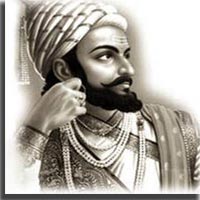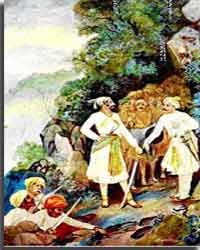History :
The Maratha Empire or the Maratha Confederacy is located in the south west of present-day India. The rule was from 1674 to 1818 and the empire extended its territories and covered much of South Asia. The founder and consolidater of the Maratha Empire was Shivaji Bhosale. After the death of Mughal Emperor Aurangzeb the empire expanded greatly under the rule of the Peshwas, the Prime Minister of the empire.
In 1761, the Maratha army lost the Third Battle of Panipat which halted the expansion of the empire. Later, the empire was divided into a confederacy of Maratha states which eventually were lost to the British in the Anglo-Maratha wars by 1818. Under Commander Kanhoji Angre a large portion of the empire was coastline and secured with a potent navy under commanders. He was very successful in keeping foreign naval ships, particularly Portuguese and British, under check.[1] Building and securing seaside as well as land based forts played an important role in Maratha's military history.
RAfter a lifetime of exploits with Adilshah of Bijapur and Mughal King Aurangzeb, King Shivaji the Great founder of independent Maratha kingdom in 1674 formed Raigad as its capital. Shivaji expired in 1680, leaving a large, but vulnerably located kingdom. The Mughals invaded, fighting an unsuccessful from 1681 to 1707 for 27 years. Shahu, a grandson of Shivaji, ruled the empire til 1749. During his reign, Shahu appointed a Peshwa (prime minister) as head of government under certain conditions. After the death of Shahu, the Peshwas were made to become the de facto leaders of the Empire from 1749 to 1761, in the base of Satara the Shivaji's successors continued as nominal rulers.
The Maratha Empire king kept the British forces at bay during the 18th century Covering a large part of the subcontinent. The dynasty was at his height in the 18th century under Shahu and the Peshwa Baji Rao I. Third Battle of Panipat which had many losses in 1761 suspended further expansion of the empire in the North-west and reduced the power of the Peshwas. After severe losses in the Panipat war, the Peshwas started gradually losing control of the kingdom. Shinde, Holkar, Gaikwad, PantPratinidhi, Bhosale of Nagpur, Pandit of Bhor, Patwardhan, and Newalkar the Many military chiefs of the Maratha Empire started to work towards their ambition of becoming kings in their respective regions. However, under Maratha authority in North India was restored, 10 years after the battle of Panipat by Madhavrao Peshwa, after his death the empire gave way to a loose Confederacy, with political power resting in a 'pentarchy' of five mostly Maratha dynasties.
Place |
Maharashtra, Madhya Pradesh, Haryana, Karnataka, Andhra pradesh, Tamil Nadu |
Period |
1674 to 1818 |
Language |
Marathi, Kannada, Konkani, Gujarati, Hindi, Tamil |
Rulers |
Chattrpathi Shivaji, Chatrapati Sambhaji, Rajaram and Tarabai, Shahu |
Religion |
Hinduism |
Chatrapati Shivaji

The dynasty thus became much more aggressive, frequently raiding Mughal territory and ransacking the Mughal port of Surat in 1664 and again in 1670. Shivaji proclaimed himself king taking the title (Chhatrapati in 1674).
The great Shivaji Maharaja died in 1680 and during this period the Marathas had expanded their territory to include some parts of central India but later lost it to the Mughals and the British.

Chatrapati Sambhaji
Chatrapati Shivaji had two sons namely Sambhaji and Rajaram. Sambhaji, the elder son, was very popular among the courtiers as he was a poet, great politician and a great warrior. In 1681, Sambhaji had himself crowned and resumed his father's expansionist policies and had earlier defeated the Portuguese and Chikka Deva Raya of Mysore. With his entire imperial court, administration, and an army of about 400,000 troops he proceeded to conquer the sultanates of Bijapur and Golconda. During the eight years that followed, Sambhaji led the Marathas, never losing a battle or a fort to Aurangzeb.
Rajaram and Tarabai
Rajaram, Chattrapati Sambhaji's brother, ascended the throne. Mughals laid siege to Raigad. Rajaram fled to Vishalgad and then to Jinji for safety. From there Marathas raided the Mughal territory and many forts were captured by Maratha commanders Santaji Ghorpade and Dhanaji Jadhav. In 1697, Rajaram offered a truce but this was rejected by the emperor. Rajaram died in 1700 at Sinhagad. His widow, Tarabai, assumed control in the name of her son Ramaraja (Shivaji II). Then Tarabai heroically led the Marathas against the Mughals; by 1705, they had crossed the Narmada River and entered Malwa, then in Mughal possession.
Malwa was a decisive battle for the Maratha Empire. The Mughals lost their eminent position on the Indian subcontinent forever and the subsequent Mughal Emperors became titular kings. The Marathas emerged victorious after a long drawn-out and fiercely fought battle. The soldiers and commanders who participated in this war achieved the real expansion of the Maratha Empire. The victory also set the foundations for the imperial conquests achieved later, under the Peshwas.
Shahu
After Emperor Aurangzeb's death in 1707, Shahuji, son of Sambhaji (and grandson of Shivaji), was released by Azam Shah, the next Mughal emperor, under conditions which rendered him a vassal of the Mughal emperor but his mother was still held captive to ensure good behaviour from Shahuji. He immediately claimed the Maratha throne and challenged his aunt Tarabai and her son. This promptly turned the now-spluttering Mughal-Maratha war into a three-cornered affair. The states of Satara and Kolhapur came into being in 1707, because of the succession dispute over the Maratha kingship. By 1710 two separate principalities had become an established fact, eventually confirmed by the Treaty of Warna in 1731.
In 1713 Farrukhsiyar declared himself Mughal emperor. His bid for power depended heavily on two brothers, known as the Saiyids, one of whom was the governor of Allahabad and the other the governor of Patna. However, the brothers had a falling-out with the emperor. Negotiations between the Saiyids and Peshwa Balaji Vishwanath, a civilian representative of Shahu, drew the Marathas into the vendetta against the emperor.
Notable Marathas
- Chattrapati Shivaji Maharaj (1630-1680) - Founder of the Maratha Empire
- Chattrapati Sambhaji Maharaj, son of Shivaji; Second Emperor of Maratha Empire; Dharmaveer.
- Punyaslok Rajmata Ahilyadevi Holkar, queen of the Malwa region
- Kanhoji Angre, a Maratha Navy Supremo who was on the side of Maharani Tarabai and was later convinced by Balaji Vishwanath Bhat to come over Shahu's side.
- Hambirrao Mohite, commander in chief, also known as Sarnobat who took the side of Sambhaji even though he was brother of Soyarabai and fought against Mughals
- Santaji Ghorpade, commander in chief who led the fight against the Mughal Empire.
- Madhavrao I Scindia (Mahadji Shinde), a ruler from Gwalior who led the Marathas in Pune in the first Anglo-Maratha war.


